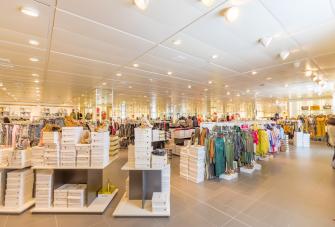Creating operational consistency across multiple retail locations
Imagine walking into your favorite store. It’s in your neighborhood. The staff are friendly, the shelves are always perfectly stocked, everything just works.
Now imagine you’re in another part of the city, maybe across town, and you hear that your store is opening there too. You're like, “No way! I love that place!” You’re already picturing grabbing your usual, chatting with the staff, feeling at home even in a totally different location.
But then… You walk in, and something’s just off. It looks the same. The name's the same. But the energy? The service? The experience? Totally different.
That moment, that little disconnect, is what we’re here to talk about today. Because creating that same great experience, across multiple business locations is extremely important for a retail business owner. Let’s get into why.
Why operational consistency matters in multi-store retail
Before we jump into the how, how to manage multiple stores, how to run a multi-location business without losing your mind, let’s take a minute to talk about the why. Why this stuff matters. Why it’s not as easy as just copy-and-pasting your first store and hoping for the best.
When you open a second (or third, or tenth) store, things get complicated. You’ve got different teams, different managers, and maybe even different local customer needs.
That means things don’t always get done the same way, and that’s where problems start.
If every store is doing things differently, your brand starts to feel all over the place. That’s why keeping things consistent (behind the scenes and out on the shop floor) is so important.
Common challenges for businesses with multiple locations
Here are some of the most common issues multi-store businesses face:
- Different systems in different stores: One store might use one POS system, and another might use something totally different.
- Inconsistent staff training: If your training isn’t standardised, each team learns things a different way.
- Communication gaps: Without a clear way for stores to stay in touch with HQ or each other, important updates can get missed.
- Mixed customer experiences: If one location is warm and welcoming and another is rushed or sloppy, customers notice, and might not come back.
Benefits of standardized operations
Getting all your stores running in a consistent way comes with loads of benefits:
- More sales: When all locations do things the same way, your business usually makes more money. In fact, 68% of businesses say they grow their revenue by at least 10% just by being consistent. Some even grow by 23%. This happens because customers get the same good experience every time, so they buy more and come back often.
- Better customer loyalty: Customers really like it when you talk to them and treat them the same way no matter which store they visit. That’s why 79% of customers stay loyal when communication is consistent. Around 36.5% say they feel more connected and trust your brand more because everything feels familiar. This loyalty means they choose your stores over others.
- Trust and recognition: Not all businesses make sure their brand looks and feels the same everywhere. Only about 30% really enforce brand guidelines. But those that do make their stores look and feel the same, which helps people recognize the brand easily. When customers recognize a brand, they trust it more and feel comfortable shopping there.
1. Establishing brand standards across all locations
Think of brand standards as the “rules” for how your business looks and feels to customers. This includes things like:
- Your logo
- The colors you use in your store and on your website
- The style of signs and menus
- How employees talk to customers
- How products are displayed on shelves or counters
- The overall feel or atmosphere
Here’s a real-world example looking at two very different clothing brands:
Luxury retailer Jacquemus nails high-fashion with minimalist designs, clean spaces, and a luxe, exclusive feel. Their stores are calm, elegant, and every detail screams premium.
Urban Outfitters is young, affordable, and playful. Think bright colors, bold signs, trendy displays, and a laid-back, chatty crew. It’s more like your cool hangout spot.
Even though these brands are completely different, each one sticks to its own brand standards at every location. That’s what helps their customers know exactly what kind of experience to expect.
Tools for enforcing visual and service standards
How do you actually make sure every store sticks to those brand standards? How do you keep the look, feel, and service the same across multiple locations without driving yourself nuts? Here are some key tools that help with that:
- Brand manuals and style guides: The go-to playbook for logos, colors, fonts, signage, and even how staff should greet customers. Share these with every manager and employee.
- Training programs and workshops: Don’t just drop a manual and run. Regular workshops or online training keep everyone sharp on customer service, product know-how, and store vibe.
- Visual merchandising software and checklists: Apps that show exactly how to arrange products on shelves. Managers can tick off tasks to make sure displays look right every time.
- Mystery shoppers and regular audits: Get fresh eyes on your stores. Mystery shoppers act like customers and report back on cleanliness, friendliness, and how well brand standards are followed.
- Cloud-based communication platforms: Tools like Slack or Teams make sure updates, announcements, and feedback fly fast between locations.
2. Centralizing store management tools
Our next way of keeping brand and operational consistency across one or more locations is all about centralizing your store management tools.
Centralizing just means bringing all those tasks into one place. Instead of hopping between apps or spreadsheets, you get one system that helps you track sales, manage inventory, monitor key performance indicators, and support your teams, all from one dashboard.
Now, you've probably seen this in action without even knowing. Here's a few examples IRL:
- If you've ever been in a store and one of the product offerings you wanted isn't available, maybe it's out of stock in the small business you're currently in, then an employee checks the system and tells you it’s available at another location, that’s centralized inventory management doing its thing.
- If you noticed that you noticed a sale or promotion going on at all the stores at the same time. That’s store management tools helping keep the same marketing strategies and promotion strategy across multiple locations.
Why cloud-based POS systems are essential
The way to centralize your retail store management is via a cloud-based POS system.
This system brings together sales, inventory, employee management, and marketing tools all in one place.
It helps you track everything in real-time across multiple locations, making it easier to run your stores smoothly and keep your brand consistent.
Benefits of integrated inventory and sales tracking
- Connected inventory and sales tracking shows what’s happening in every store, all in one place.
- You can see which products sell fast and which don’t.
- No more guessing or surprises like running out of stock or having too much stuff.
- Saves money by avoiding extra inventory and lost sales.
- Keeps customers happy because they find what they want.
- Helps you plan smarter for the future.
- Tracking sales data helps you understand customers better.
- Lets you make quick decisions to boost sales and grow your business.
3. Training and empowering your teams
We’ve talked about brand standards and centralizing your tools. Now, let’s get into something super important — training your teams right, no matter which store they work in.
Delivering the right training across locations
You’ve got employees spread out across multiple stores. How do you make sure everyone’s on the same page? How do you make sure they all know the ropes, and know your way of doing things?
That’s why delivering the right training is a total game-changer. You want training that’s simple, easy to follow, and easy to get to. Online videos, quick guides, live sessions, whatever works for your team.
When everyone gets the same training, customers get the same experience. No surprises. No confusion.
Maintaining employee engagement and performance
But wait, training isn’t just a one-time thing, right? You've also got to keep your team feeling good about their work.
Check in with them. Give them props when they’re doing great. Help them when they’re struggling. Make sure they feel part of the team, even if your stores are miles apart.
Happy, engaged employees do better work. They sell more, serve better, and stick around longer. That’s good news for your sales, your customers, and your bottom line.
4. Managing inventory across multiple stores
Managing inventory across multiple business locations means knowing exactly what you have, where it is, and when you need to restock. Sounds simple, but trust us, it gets tricky fast.
Best practices for stock visibility and transfers
First up — stock visibility. This just means being able to see your inventory levels across all your stores in real-time. If you’re running a multi-location business, you need to know what’s in stock at each store. Why? Because:
- You don’t want to lose sales when a customer wants something that’s out of stock at their nearest store.
- You don’t want to waste money buying more of something that’s sitting on shelves at another location.
The easiest way to fix this is by using introducing a tech stack that tracks inventory for you. It’s part of store management software or your retail POS system. When one store runs low on a popular item, you can transfer stock from another location that has plenty. This keeps your customer base happy because they get what they want. Plus, it stops you from spending extra money buying the same thing twice.
Avoiding overstocking and stockouts
These are the two main reasons inventory can mess up your retail business:
- Overstocking: buying too much of something. This ties up your money in stuff that’s not selling. It also clutters your store and makes managing inventory harder.
- Stockouts: running out of popular products. This means lost sales, frustrated customers, and worse, those customers might never come back.
Both are bad news for your small business or multi-location business.
To avoid this, you need to track your key performance indicators - like how fast products sell, what customers want, and when to reorder. Good inventory management helps you keep the right product offerings in the right places at the right time.
Our Complete Solution
Delight shoppers as you speed up sales and grow your business. Tailor your Epos Now retail POS business tools to your exact needs with the Epos Now AppStore.
5. Unifying marketing strategies
Having unified marketing strategies just means making sure your marketing, all those ads, emails, social posts, promotions, works together across all your stores or locations. You want everything to feel like it’s coming from the same brand, no matter which store a customer visits or hears from.
That means your message, look, and vibe all line up. This helps people recognize you instantly and trust you. But, you also need to keep things flexible enough to fit the unique needs of each location.
So, unifying your marketing means balancing the “same brand” feel with the “local store” touch.
Tailoring campaigns while staying on-brand
Now, how do you actually do that?
Start with the basics: keep the same colors, logos, and tone everywhere. That’s your foundation.
Then, let each store tweak campaigns based on their own customers. Say your retail stores in the city attract young professionals — you might run promotions on quick lunch deals there.
Meanwhile, suburban locations might focus on family-friendly products or weekend events.
The goal is to tailor your promotion strategy for each place but keep everything sounding like one big, happy family.
Tracking ROI and customer engagement per location
You need to keep an eye on key performance indicators like sales bumps after a campaign, new customers who come in, or how many people actually engage with your marketing online.
Using technology, like cloud-based business solutions and marketing apps linked to your POS systems, lets your managers see all this info split by store. That way, they know exactly what marketing strategies are bringing in more customers and making money, and what’s just noise.
6. Monitoring KPIs to maintain operational consistency
KPIs tell you how well everything’s working. If you run multiple stores or have a multi-location business, you want every store hitting the same goals, delivering the same great experience, and making the money you expect.
Key metrics every multi-location business should track
So, what KPIs should you be watching? Here are the main ones:
- Sales by location: How much money is each store bringing in?
- Inventory turnover: How fast is stuff selling?
- Customer footfall: How many potential customers are walking in?
- Conversion rates: Of all those customers walking in, how many actually buy something?
- Employee performance: Are your employees hitting their targets per purchase?
- Customer satisfaction scores: Happy customers mean repeat business, which is the goal for all your locations.
Using data to inform decisions and improve performance
Measuring these KPIs can be done using a cloud-based POS system that offers data analytics. You can then use them to make informed decisions.
Say you notice one store’s sales are down, but foot traffic is high. That could mean your team needs better training or the product offerings don’t match what local customers want.
Or maybe a promotion strategy worked great at one location but flopped at another, that’s useful info to tweak your future campaigns.
7. Leveraging technology for scalable growth
Scalable growth means growing your business in a way that works no matter how many stores or locations you add. It’s about making sure your systems, teams, and processes can handle more without breaking or getting messy. So whether you’re running two stores or twenty, things still run smoothly.
Using automation to support expansion
Now, how do you actually make that happen? One of the best ways is through automation.
Automation means using technology to handle repetitive tasks for you. Like managing inventory, updating sales numbers, or even sending marketing messages. This saves you and your managers loads of time and stops things from slipping through the cracks.
How to prepare systems and teams for scaling
But before you start adding new locations, you’ve got to prepare by:
- Picking POS, payment processing, and inventory systems that work online so all stores connect in real-time
- Creating clear, simple checklists and guides for everything
- Getting your store managers fully comfortable with the new systems and processes before rolling them out to staff. They’ll be your on-the-ground experts
- Setting up automated reports, reorder alerts, and marketing campaigns to reduce manual work and keep things running smoothly as you grow
- Asking your teams what’s working and what’s not. Use their input to tweak systems and training before adding more locations
- Having a dedicated tech or operations person ready to help managers and staff quickly with any issues, so problems don’t slow down the whole business
Conclusion: Creating alignment across retail locations
So there you have it, our complete guide on how to manage multiple stores while still keeping operational consistency.
Consistency as a competitive advantage
Being consistent isn’t just about looking good. It’s what makes customers trust you and keep coming back. Plus, it gives you a real edge over other businesses that are all over the place.
Next steps for multi-store success
So, what do you do now? Start by locking down your brand. Get the right tools to manage all your stores from one spot. Train your people well. Watch your numbers. Keep improving. Do that, and you’ll be crushing it with your multi-store business in no time.
FAQs
- How do I manage operations across multiple retail stores?
-
Managing operations across multiple retail stores means using systems and processes that keep everything running smoothly from one place.
- Why is consistency important in a multi-store retail business?
-
Consistency matters because it builds trust with customers and keeps your brand strong no matter where they shop.
- What tools help maintain consistency between locations?
-
Tools like cloud-based POS software and centralized dashboards help keep things consistent between locations.
- How can I train staff effectively across different stores?
-
Effective staff training happens when you use clear guidelines, regular check-ins, and easy-to-access training materials across all stores.
- What are the best practices for managing inventory in multiple stores?
-
The best way to manage inventory in multiple stores is by tracking stock levels in real time and moving products between locations when needed.
- How do I keep brand messaging consistent across all locations?
-
Keeping brand messaging consistent means using the same visuals, tone, and customer experience in every store.
- Which KPIs should I track for multi-location performance?
-
Track KPIs like sales, conversion rates, inventory turnover, and customer satisfaction to see how each location is performing.
- What technology supports businesses with multiple locations?
-
Small business technology like integrated POS systems, inventory software, and communication apps makes managing multiple locations easier.
- How can I ensure all store managers follow the same procedures?
-
Ensuring store managers follow the same procedures means providing clear training, regular updates, and support tools.
- What’s the first step to improving multi-store management?
-
The first step to improving multi-store management is creating a clear plan for consistency and choosing the right tools to support it.




